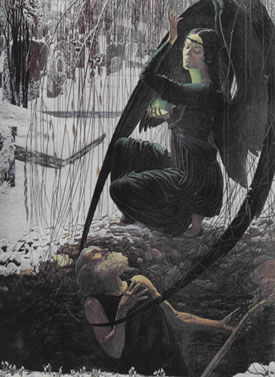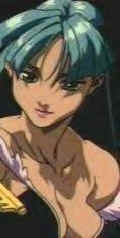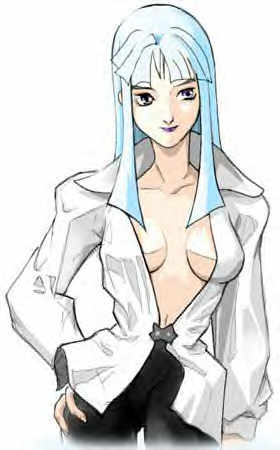Information on Morrigan
Morrigan -
(Celtic; symbol:crow)
may appear as both a single goddess of battle, strife and fertility and
as a trio of goddesses. She was able to render men helpless, not only in
battle but also when they did not recognize their own feminine power.
MORRIGHAN
- Gaul-All celtic tribes
Morrighan was the Celtic goddess of war and death who could take the
shape of a crow or raven. She is associated with the sometimes
frightening aspects of female energy, and is wife to Dagda. As one
aspect of the Celtic triple goddess, Morrigan is seen washing bloody
laundry prior to battle by those destined to die.
Morrigan
Conway, D.J. The Ancient & Shining ones. St. Paul, MN: Llewellyn
Publications, 1993. 226
Graves, Robert. The White Goddess. New York: The Noonday Press, 1991.
143
Morrigan/The Morrigu"Great Queen"; "Supreme War
Goddess"; "Queen of Phantoms or Demons"; "Specter Queen"; shape shifter. Reigned over the battlefield, helping with
her magick, but did not join in battles. Associated with crows and
ravens. The Crone aspect of the Goddess; Great Mother; Moon Goddess;
Great White Goddess; Queen of the Fairies. In her Dark Aspect (the
symbol is then the raven or crow) she is the Goddess of war, fate, and
death; she went fully armed and carried two spears. The carrion crow is
her favorite disguise. With her, Fea (Hateful), Nemon (Venomous), Badb
(Fury), and Macha (Battle) encouraged fighters to Battle-madness.
Goddess of rivers, lakes, and fresh water. Patroness of priestesses and
witches. Revenge, night, magick, prophecy.
Queen"; shape shifter. Reigned over the battlefield, helping with
her magick, but did not join in battles. Associated with crows and
ravens. The Crone aspect of the Goddess; Great Mother; Moon Goddess;
Great White Goddess; Queen of the Fairies. In her Dark Aspect (the
symbol is then the raven or crow) she is the Goddess of war, fate, and
death; she went fully armed and carried two spears. The carrion crow is
her favorite disguise. With her, Fea (Hateful), Nemon (Venomous), Badb
(Fury), and Macha (Battle) encouraged fighters to Battle-madness.
Goddess of rivers, lakes, and fresh water. Patroness of priestesses and
witches. Revenge, night, magick, prophecy.
Morgan in Irish legend is "the Morrigan", meaning "Great
Queen", a Death-goddess who assumed the form of a raven; and
"le Faye" means "the Fate". According to Cormac's
Glossary the Morrigan was invoked in battle by an imitation on war-horns
of a raven's croaking. She was by no means the gentle character familiar
to readers of the Morte D'Arthur but was like the "black screaming
hag Cerridwen" big mouthed, swarthy, swift, sooty, lame, with a
cast in her left eye.
The Morrigan (Morrigu)
by Danielle Dee
The Morrigan is a goddess of battle, strife, and fertility. Her name
translates as either "Great Queen" or "Phantom
Queen," and both epithets are entirely appropriate for her. The
Morrigan appears as both a single goddess and a trio of goddesses. The
other deities who form the trio are Badb ("Crow"), and either
Macha (also connotes "Crow") or Nemain ("Frenzy").
The Morrigan frequently appears in the ornithological guise of a hooded
crow. She is one of the Tuatha Dé Danann ("Tribe of the goddess
Danu") and she helped defeat the Firbolgs at the First Battle of
Mag Tuireadh and the Fomorians at the Second Battle of Mag Tuireadh.

Origin
The origins of the Morrigan seem to reach directly back to the
megalithic cult of the Mothers. The Mothers (Matrones, Idises, Disir,
etc.) usually appeared as triple goddesses and their cult was expressed
through both battle ecstasy and regenerative ecstasy. It's also
interesting to note that later Celtic goddesses of sovereignty, such as
the trio of Eriu, Banba, and Fotla, also appear as a trio of female
deities who use magic in warfare. "Influence in the sphere of
warfare, but by means of magic and incantation rather than through
physical strength, is common to these beings."
Eriu, a goddess connected to the land in a fashion reminiscent of the
Mothers, could appear as a beautiful woman or as a crow, as could the
Morrigan. The Disir appeared in similar guises. In addition to being
battle goddesses, they are significantly associated with fate as well as
birth in many cases, along with appearing before a death or to escort
the deceased.
There is certainly evidence that the oncept of a raven goddess of battle
wasn't limited to the Irish Celts. An inscription found in France which
reads Cathubodva, 'Battle Raven', shows that a similar concept was at
work among the Gaulish Celts.
Similarities between the morrigan and the Valkyries The Morrigan's role
in the Irish cosmology is quite similar to the role played by the
Valkyries in Norse cosmology. Both use magic to cast fetters on warriors
and choose who will die.
During the Second Battle, the Morrigan "said she would go and
destroy Indech son of De Domnann and 'deprive him of the blood of his
heart and the kidneys of his valor', and she gave two handfuls of that
blood to the hosts. When Indech later appeared in the battle, he was
already doomed."
Compare this to the Washer at the Ford, another guise of the Morrigan.
The Washer is usually to be found washing the clothes of men about to
die in battle. In effect, she is choosing who will die.
An early German spell found in Merseburg mentions the Indisi, who
decided the fortunes of war and the fates of warriors. The Scandinavian
"Song of the Spear", quoted in "Njals Saga", gives a
detailed description of Valkyries as women weaving on a grisly loom,
with severed heads for weights, arrows for shuttles, and entrails for
the warp. As they worked, they exulted at the loss of life that would
take place. "All is sinister now to see, a cloud of blood moves
over the sky, the air is red with the blood of men, and the battle women
chant their song."
An Old English poem, "Exodus", refers to ravens as choosers of
the slain. In all these sources, ravens, choosing of the slain, casting
fetters, and female beings are linked.
"As the Norse and English sources show them to us, the walkurjas
are figures of awe an even terror, who delight in the deaths of men. As
battlefield scavengers, they are very close to the ravens, who are
described as waelceasega, "picking over the dead"..."
"The function of the goddess [the Morrigan] here, it may be noted,
is not to attack the hero [Cu Chulainn] with weapons but to render him
helpless at a crucial point in the battle, like the valkyries who cast
'fetters' upon warriors...thus both in Irish and Scandinavian literature
we have a conception of female beings associated with battle, both
fierce and erotic."
The Morrigan and Cu Chulainn
She appeared to the hero Cu Chulainn (son of the god Lugh) and offered
her love to him. When he failed to recognize her and rejected her, she
told him that she would hinder him when he was in battle. When Cu
Chulainn was eventually killed, she settled on his shoulder in the form
of a crow. Cu's misfortune was that he never recognized the feminine
power of sovereignty that she offered to him.
She appeared to him on at least four occasions and each time he failed
to recognize her.
1. When she appeared to him and declared her love for him.
2. After he had wounded her, she appeared to him as an old hag and he
offered his blessings to her, which caused her to be healed.
3. On his way to his final battle, he saw the Washer at the Ford, who
declared that she was washing the clothes and arms of Cu Chulainn, who
would soon be dead.
4. When he was forced by three hags (the Morrigan in her triple aspect)
to break a taboo of eating dogflesh.
THE MORRIGAN
Stone, Merlin Ancient Mirrors of Womanhood. Boston Beacon Press. 1990
49-52

The Morrigan is a major figure in the Irish epic Tain Bo Cuaigne. The
narrative of the epic makes it clear that The Morrigan's loyalties are
with the Tuatha de Danaan and the Celtic tribes that had settled in the
area of the large nation/state of Connacht. Though at times there is a
tendency on the part of some to attribute a triple nature to Goddess
images from all cultures, even when there is a complete absence of
evidence of triplicity, there is no doubt about the triple nature of The
Morrigan. This concept of the threefold nature of the Goddess among the
Celts may also be seen in the Goddess as Bridget, as well as in the
Three Matrons or Mothers who were often depicted in Celtic art, sitting
side by side. But unlike the more sedentary images of The Mothers, The
Morrigan was extremely active, even aggressive, and certainly always
acting with a comfortable self-assurance.
Triple imaged Morrigan, triple named Morrigan, Mighty Queen, Badb and
Macha -it was She who protected the Tuatha de Danaan by cover of fog and
rain and cloud so that the people of Danu could land safely upon the
coast of Ireland. Those who say that She was three parts in one, say
many things about Her: some say She was the three phases of the silver
moon, waxing, full and waning, while others speak of the Three Mothers,
The Divine Matronae who sat side by side with cornucopias of abundance
upon their laps; some explain that The Morrigan was Maiden, Matron and
Crone, saying that The Holy Trinity was once the Daughter, the Mother
and the Grandmother.
Some saw Her as a vengeful crone, chortling in delight at spilled blood
upon a battlefield, drowning enemy princes beneath Her white waves,
battling against the Fomorians and the Fir Bolgs to protect those of the
tribe of Danu. To others, She appeared as a young woman dressed in
brightly coloured cloths embroidered with threads of glistening gold.
Changing shape and form was but play to the mighty Goddess-and poetry
and prophesy Her natural tongue.
Loud was Her war cry when She took the form of Badb; sharp were Her
spears; powerful were Her enchantments; true were Her grim prophesies-as
She flew across Celtic battlefields black as the sleek raven, making
Herself visible only to those whose life would soon be over, Her raven
caw filling hearts with dread, as death's call slid from Her widespread
wings. And as The Mighty Queen, She took Dagda's body into Her own while
Her feet were firmly planted upon opposite banks of a wide flowing
river, from this joining giving birth to Mecha who had three serpents in
his three hearts.
How filled with anger was The Morrigan when the lad named Odras used Her
sacred bull to mate with his cow. Gathering up both bull and cow, She
took them through the oak woods of Falga and brought them to the cave at
Cruachan, not far from the River Shannon, where one might enter into the
Otherworld. Desiring to retrieve his cow, Odras followed as fast as his
legs would move but the fleet footed Morrigan, even with the burden of
bull and pregnant cow, soon outdistanced the exhausted fellow-arriving
at the cave of Cruachan while Odras was still far behind. When She later
came upon him in the woods, his eyes closed deep in the sleep of his
fatigue, She laid a magic spell upon him so that he changed into a pond,
his spirit captive in the water of the oak woods of Falga until this
very day.
But it was the warrior of Ulster, the arrogant Cu Chulainn, who most
aroused the anger of The Mighty Morrigan. Some say that Her feud with
him first began on the day that She had watched him bathing by a river
bank and upon seeing his bared body, desired to lay him down beside Her.
It was then that She approached him in Her finest robes, embroidered
with all the colours of the rainbow. Though all the other soldiers could
hardly look upon Her, so filled were they with awe and admiration, Cu
Chulainn refused Her suggestion that he lie with Her in love, claiming
that he was too weary from the day's battle.
Still, it was not this refusal that angered The Mighty Morrigan, who
showed much patience and concern for the man that She desired, for She
then suggested that She would help him in the battle and with the energy
that he would save by Her conquests in the fighting, he would be able to
accept Her offer of a loving bed. But this second offer was responded to
with great disdain at the very idea of a woman helping in the battle and
it was this reply that aroused the wrath of The Morrigan-thus making Cu
Chulainn an enemy of the powerful Daughter of Eternity.
So it came about that on a morning when Cu Chulainn still lay fast
asleep, he was wakened by a noise so loud and startling that it caused
him to tumble from his bed on to the floor and to then rush half asleep
through the door without a stitch of clothing. Jumping into his battle
wagon, naked and unarmed, the mist of steep began to clear and Cu
Chulainn soon realized that although his intent was to ride to a battle,
he did not know in which direction he had meant to go.
Sitting there in naked puzzlement, he saw another wagon approach, that
one drawn by a single bright red horse that walked upon three legs and
pulled the vehicle behind it by a pole that ran directly through its
body-the tip of the wagon pole emerging from between the horse's eyes.
Alongside the horse walked a footman, a forked wand of hazel in his
hand. And upon the high seat of the wagon sat a woman whose hair and
thick brows were the colour and brilliance of flame, Her long cloak of
blood colour spread out about Her-as if She sat upon a throne.
Ever more puzzled and confused, Cu Chulainn asked their names and
purpose. But he found that the riddles that he received as answers were
far beyond his ken. As he added questions to his questions, the riddles
grew in sarcasm so that his confusion soon became frustration. Just as
he realized what a fool he must seem, sitting naked and unarmed in his
own wagon, puzzled by words of his own language, holding the reins but
ignorant of his intended destination-all disappeared except the woman,
who suddenly became a great black bird, cawing in laughter at his plight
as Her wings slid off into the morning air.
But Morrigan was not satisfied to have shown the man a fool. When next
the warrior Cu Chulainn fought upon a battlefield, She gathered fifty
white heifers and linking them together with a perfect silver chain, She
took the form of a heifer without horns, thus leading the herd across
the fields and waters-until the confusion they had caused among the
troops of Cu Chulainn gave the advantage to his enemy. The Morrigan then
made Herself into a long black eel and twisted about the arms and legs
of Cu Chulainn so that he was unable to move in the waters but just as
he was almost able to pull the eel from his body, She became a sharp
toothed wolf, cutting deep and painful gashes on his arms. In this way
they battled, until the dark of evening began to cover all. Then She
left him on the battlefield-knowing that he would make his way towards
home to heal his cut and broken body.
The Morrigan too had been badly hurt, especially about the face and
eyes. Realizing that She could best be healed by the one who had caused
the wounds, if She could win three blessings from him, She soon devised
a plan. So it was that at the next noon, She became an old woman with a
milking pail, sitting with a cow by the side of the road, the path that
Cu Chulainn would have to take upon his journey to his home. When he
came along the road, as She knew that he must do, his body as dry and
tired as She suspected, She called out the offer of a cup of milk,
suggesting that it might be pleasant to feel the wetness upon his
throat. Not knowing who the woman was, he came gratefully to Her side
and drank the creamy liquid from the cup, blessing Her for Her kindness
as he took the empty cup from his mouth. When She poured a second time,
again he drank and blessed the woman and yet a third time did he do the
same until-thrice blessed-The Morrigan was healed.
Cu Chulainn was startled as The Morrigan then spread Her raven wings and
more so when the old woman disappeared and the large raven that took Her
place perched itself upon a nearby bramble. It was then that he heard
the shrill cawing prophesies of a future grim and short in time, and
watched as the wide black wings of The Morrigan disappeared into the
distance-as he stood earthbound and fearful of Her wrath and magical
powers.